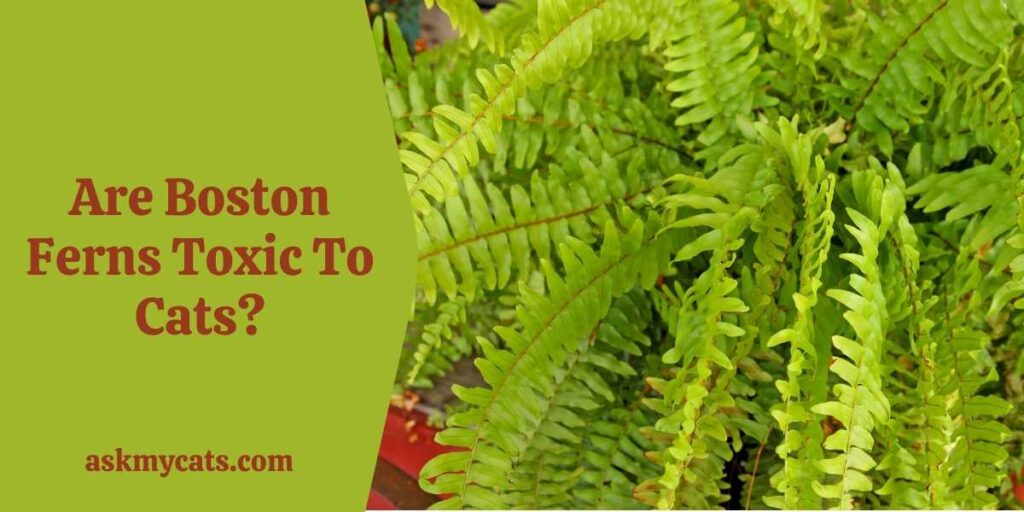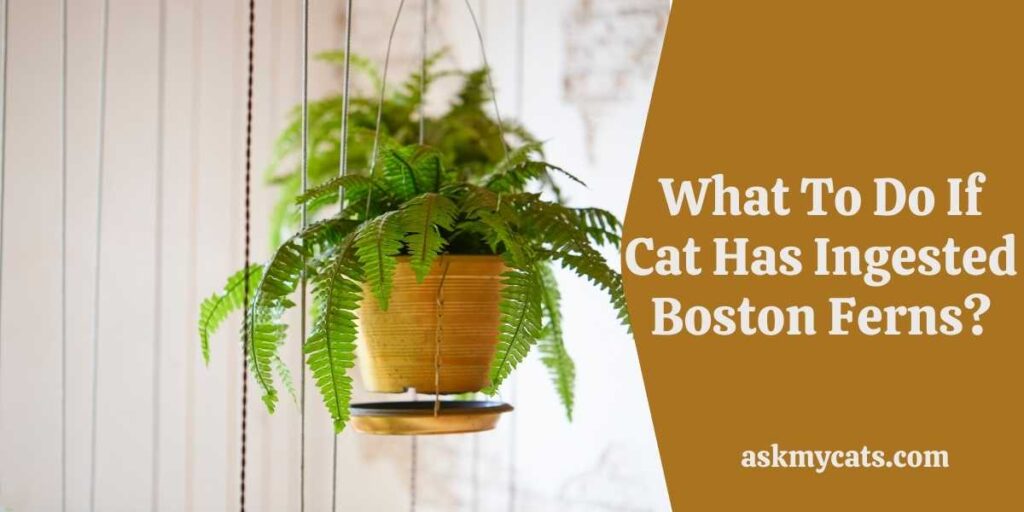Houseplants add to the design and feel of your house by reflecting a decorator’s style and horticultural prowess. They absorb carbon dioxide and release oxygen, enhancing air quality, and they provide the required humidity to dry air through transpiration.
Many lovely plants, like certain fern species, are, however, exceedingly toxic to pets and can cause serious illness or even death.
So, are Boston Ferns toxic poisonous to cats?
No, Boston Ferns are not toxic to cats. They are non-toxic to both cats and dogs, according to the ASPCA. This indicates that it is a non-toxic, safe plant to have in and around your home.
This article will educate you more about the relationship between cats and Boston Ferns.


Give Your Cat the Perfect Day
Get the Free Ebook!
What Are Boston Ferns?
The Boston fern, sometimes known as the sword fern, is a fern species of the Lomariopsidaceae family that is native to tropical climates all over the world.
The Boston fern (Nephrolepis exaltata), often known as the sword fern, grows in numerous tropical places across the world.
It’s typically kept as a houseplant because it doesn’t require a lot of sunshine. This fern’s leaves stay green all year.
Its sword-shaped, blue-green fronds are erect and arch as they grow larger, with many small leaflets.
The Boston fern, like many other fern species, grows slowly and is best planted in the fall or spring.
Boston ferns (Nephrolepis exaltata) are popular houseplants, yet they require special attention to be healthy. It isn’t difficult to learn how to care for a Boston fern, but it is specific.
The Boston Ferns not only improve indoor air quality but also improve humidity levels by naturally replenishing moisture in the air, which has a relaxing effect.
People with dry skin, dry nostrils, and sore throats can benefit from the air-purifying characteristics.
Smoking, cosmetics, resin paints, fragrances, air fresheners, and adhesives are all sources of formaldehyde, which is a prevalent indoor air contaminant.
The nose, eyes, and throat may become irritated. According to NASA tests, Boston Ferns are capable of absorbing a significant amount of formaldehyde from the environment.
Boston ferns can readily be cultivated indoors if sufficient care is taken to provide them with the proper environment.
It’s critical to keep Boston ferns in steady growing conditions, as any aspect of their care that’s out of whack will swiftly harm the plant.
Are Boston Ferns Toxic To Cats?
No, Boston ferns are not toxic to cats.

Boston ferns are excellent houseplants.
Perennials, which are frequently used in hanging baskets, offer colour and texture to a space and can be a strong addition to a design concept.
They require high humidity and do best with continually moist soil, indirect sunlight, and regular watering, despite being easy to care for.
The Boston fern is not dangerous to cats, unlike some ferns, but it can be enticing to some animals, particularly cats.
Cats and kittens love to play with the delicate fronds of the Boston fern. If your plant is harmed and your cat is spitting up fern leaves, it’s most likely because your cat ate too much of a harmless plant when left alone.
Spray the leaves with Bitter Apple or a vinegar-water solution to discourage the activity. If you find your cat in the act, give him a stern “no” to startle him.
Provide him with a variety of toys and engaging playtime to distract him from your houseplants.
While these plants aren’t poisonous to cats, consuming large amounts of any plant might induce unpleasant side effects in cats.
Your cat will probably get an upset stomach if she consumes too much Boston fern, for example.
The symptoms of swallowing a real fern, on the other hand, are rarely severe enough to require medical treatment.
Can Cats Eat Boston Ferns?
Yes, cats can eat Boston ferns, but only in moderation.

Most ferns make excellent houseplants, and the Boston Fern is one of the more gorgeous, easy-to-care-for, and entertaining ferns.
If you live with a cat – or a dog, for that matter – you’ll want to make sure your Boston Fern doesn’t offer any health risks.
Some of the most inconspicuous plants can be extremely harmful to both cats and humans.
Boston Ferns are a popular houseplant. We’ve been using them for millennia because of their numerous advantages in the home.
They add beauty and freshness to any room, for starters. You will always get what best suits you because they come in a variety of styles.
Boston ferns are also extremely low-maintenance. They can thrive both inside and out as long as they have enough water and nutritious soil.
Boston Ferns are not toxic or hazardous to cats in any manner. The American Society for the Prevention of Cruelty to Animals (ASPCA) has validated this.
So, the good news is that your Boston fern will not make your cat sick.
However, this may not be your only issue. For many cats, the long fronds are attractive and difficult to resist playing with.
Prepare to take steps to discourage this behaviour; if your cat is used to chewing on plants, they may be surprised when they bite the wrong plant in the future.
Many fern species are toxic to our adorable four-legged companions, but the Boston fern is not one of them.
It’s on the ASPCA’s list of non-toxic houseplants for cats. Both cats and dogs are drawn to it because of its matted fronds.
If your cat is one of them, you may rest assured that he is safe in its presence. He will not have runny stools, bouts of vomiting, or any of the other common plant poisoning symptoms if she eats a few leaves.
You want to make sure your cat doesn’t eat too much of the fern, as normal. Despite the fact that it is completely safe, a large volume of green matter can cause problems for the unfortunate canine.
For the most part, his gut is made to manage meat, as well as other dietary groups in smaller amounts.
What Happens If Cat Eats a Large Amount Of Boston Fern?
If your cat eats a large amount of Boston Fern, it will have the following symptoms: –
- Vomiting
- Diarrhea
- Stomach pain
- Drooling
Swelling, irritation, and blisters might occur if your cat accidentally brushes up against the plant’s leaves.
What To Do If Cat Has Ingested Boston Ferns?
If your cat has ingested a large quantity of Boston ferns, you must take her to the vet as soon as possible.

If your cat has lately nibbled on a Boston fern plant, you can generally relax.
Consumption of genuine ferns is unlikely to harm your cat unless she indulges in a particularly greedy serving, and veterinary intervention is rarely required.
If your cat eats a large quantity of Boston fern, however, you should contact your veterinarian.
Bring a sample of the plant to the clinic to test its toxicity if possible. A quick photo taken with your phone would suffice.
Your veterinarian may rinse your cat’s skin and/or mouth to eradicate all evidence of the plant when you bring her in.
Your veterinarian may also deliver intravenous fluids to treat dehydration caused by excessive vomiting or diarrhoea. Topical treatments with prescription strength can also help with skin irritation.
How To Stop Cats From Eating Boston Fern?
You can stop your cat from eating your Boston fern by following these steps: –
1. Use Repellent Spray
Now we’re talking about cat repellent sprays that you spray on your plants.
There are a variety of strong-scented products on the market that can make your cat sneeze if it goes too close, or you can manufacture your own with common home items.
A mixture of water and a strongly scented soap such as lavender or citrus can be effective, or a puree of garlic in water can be used for a similar but more pungent effect.
For a similar effect, scatter some hot chilli pepper around your plants if you need to get more serious. Just keep in mind that if the cats get too much in their nose or eyes, it might be uncomfortable. Use with caution.
2. Try Spray Bottle
This is the traditional “training” method for cats. Keep a spray bottle of water available and spritz your cat when they get too close to your plants.
Spray bottles are inexpensive and can be found online or at a local hardware store.
While this method is straightforward, it only works if you are home the majority of the time and can keep an eye on your plants.
Some cats will just become more sneaky and cause mischief while you’re not around, while others will acquire an aversion to plants as a result of this and avoid them even when you’re not present.
It’s worth a chance to see how your cat reacts, but bear in mind that this may not be suited for everyone.
3. Change The Placement Of The Boston Fern
You may have to just move your plants out of the way of your cats, which might be difficult if your cats are really agile and determined.
Hanging baskets that aren’t too close to other pieces of furniture, or even containers that mount straight to the wall (no shelf) and are out of reach, can be useful.
4. Add A Layer Of Pebbles
This is for the diggers. Your houseplants will have plenty of loose dirt for cats to dig in for their potty needs.
Apply a thick coating of hefty pebbles to the dirt’s surface.
It should still enable water to flow through to the soil beneath if it isn’t too firmly packed. It won’t have the same feel as a litter box and won’t be as appealing.
If you want a more decorative look, you could use large pieces of smooth glass, rough pine cones, seashells, or broken ceramics.
5. Clean Her Litter Box
This could be the reason why cats are going to your plant pots to relieve themselves, while some kitties will do it just to be challenging.
Ensure that their proper litter box is cleaned on a regular basis and is in a convenient location. If your cat is avoiding the litter box even when it is clean, switch to a different type of litter.
Cats can become finicky after years of using the same litter, so don’t dismiss this as a problem just because things have been “fine” for a long time.
6. Create Unpleasant Surroundings
Giving your cat a good scare can work wonders, and having something loud and surprising happen when they jump up near your plants can be enough to break the behaviour.
This works best with plants on a table or shelf with some additional area to deal with around the pots.
If a few loosely placed tin-foil plates are knocked over, for example, they can make a noise.
Depending on the location of your plants, you may need to be inventive. However, this strategy may need to be refreshed every day.
Another option is to make a sticky surface that your cat won’t want to walk on.
Double-sided tape laid out between your plant pots can be excellent to create a barrier as long as you don’t allow enough space for jumping around between the tape.
Frequently Asked Questions
What are the things to consider while growing Boston fern?
Keep an eye on the weather conditions. If the temperature drops below 65 degrees Fahrenheit, bring the plant back inside. Even in a shady location, anything over 95 degrees may be too much for the Boston fern, which thrives in heat and humidity. Watering should be done carefully to keep the soil moist.
What are the signs of possible toxic fern exposure?
After ingesting a fern plant, your cat may have abrupt vomiting, drooling, and pain. This is a sign that your cat has fern poisoning. You should contact the Pet Poison Hotline or take your cat to a veterinarian right away. If you have cats, you may want to consider removing hazardous plants from your house and replacing them with safer indoor plants like the Boston fern.
What are some poisonous ferns?
Cats can be poisoned by a variety of plants. The asparagus fern, for example, has a number of names. Avoid ferns such as the Australian nut, emerald feather, lace, Plumosa, Racermose, Shatavari, and Sprengeri to create a cat-friendly environment.
Final Words
Boston Ferns are not harmful or dangerous to cats, as you now know.
It’s up to you whether you let your cat play with the fronds (which most cats can’t get enough of). It’s simply comforting to know that there are no risks or dangers to worry about.
Ask us questions in the comments section if you have any.
